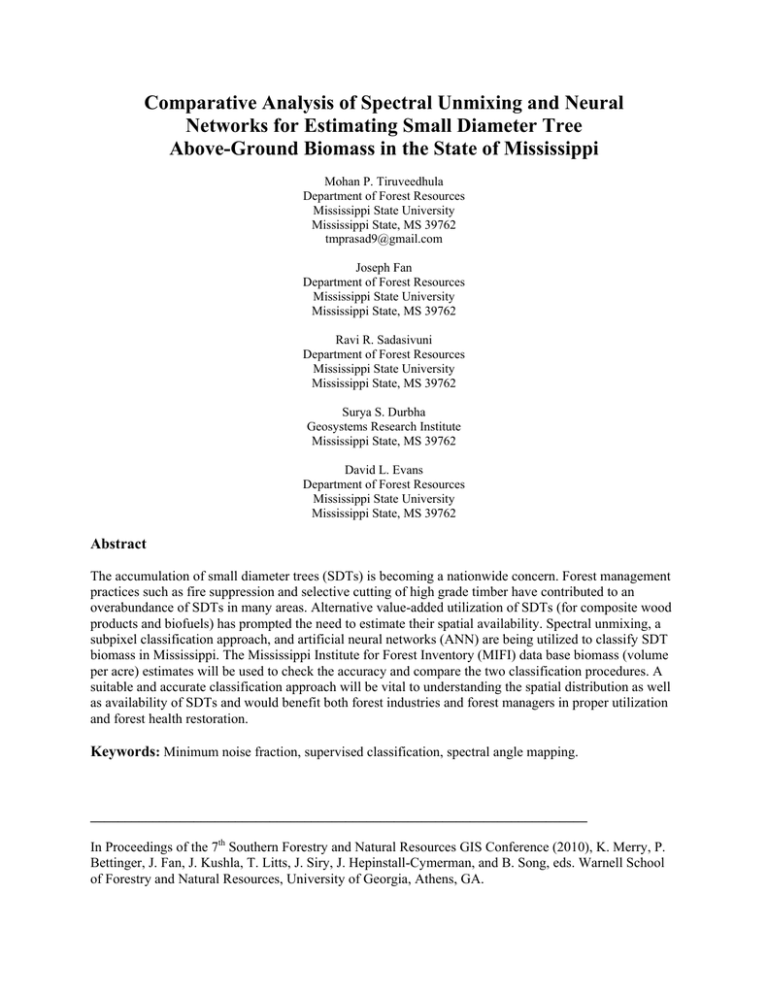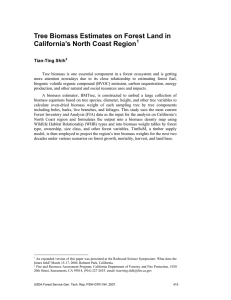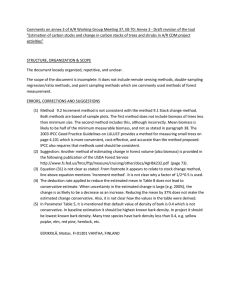Comparative Analysis of Spectral Unmixing and Neural
advertisement

Comparative Analysis of Spectral Unmixing and Neural Networks for Estimating Small Diameter Tree Above-Ground Biomass in the State of Mississippi Mohan P. Tiruveedhula Department of Forest Resources Mississippi State University Mississippi State, MS 39762 tmprasad9@gmail.com Joseph Fan Department of Forest Resources Mississippi State University Mississippi State, MS 39762 Ravi R. Sadasivuni Department of Forest Resources Mississippi State University Mississippi State, MS 39762 Surya S. Durbha Geosystems Research Institute Mississippi State, MS 39762 David L. Evans Department of Forest Resources Mississippi State University Mississippi State, MS 39762 Abstract The accumulation of small diameter trees (SDTs) is becoming a nationwide concern. Forest management practices such as fire suppression and selective cutting of high grade timber have contributed to an overabundance of SDTs in many areas. Alternative value-added utilization of SDTs (for composite wood products and biofuels) has prompted the need to estimate their spatial availability. Spectral unmixing, a subpixel classification approach, and artificial neural networks (ANN) are being utilized to classify SDT biomass in Mississippi. The Mississippi Institute for Forest Inventory (MIFI) data base biomass (volume per acre) estimates will be used to check the accuracy and compare the two classification procedures. A suitable and accurate classification approach will be vital to understanding the spatial distribution as well as availability of SDTs and would benefit both forest industries and forest managers in proper utilization and forest health restoration. Keywords: Minimum noise fraction, supervised classification, spectral angle mapping. ________________________________________________________________________ In Proceedings of the 7th Southern Forestry and Natural Resources GIS Conference (2010), K. Merry, P. Bettinger, J. Fan, J. Kushla, T. Litts, J. Siry, J. Hepinstall-Cymerman, and B. Song, eds. Warnell School of Forestry and Natural Resources, University of Georgia, Athens, GA. Introduction Small diameter trees (SDTs) include the small and pole sized classes of the USDA Forest Service, Forest Inventory and Analysis (FIA) program. More specifically, small and pole sized classes refer to trees less than 5 inches and 5 to 11 inches diameter at breast height, respectively. SDTs are often characterized as the leftover underutilized material in the dense understory that persists throughout the forest (Levan-Green and Livingston 2001). It is reported that the biomass of these SDTs and shrubs is increasing at an average rate of 237 cubic feet per second in the United States (Levan-Green and Livingston 2003). Forest management practices such as active fire suppression in the western conifers and selective cutting of the eastern hardwoods are primarily responsible for the accumulation of these SDTs. The accumulation of SDTs changes the forest structure and composition; in effect making forests more vulnerable to fires, insects, and diseases. Mapping of SDTs using geospatial technologies might enhance forest manager’s and forest industry’s efforts in combating adverse impacts while promoting proper utilization of this resource. Geospatial technologies (Geographic Information Systems and remote sensing) have been extensively used for forest biomass mapping (Zheng et al. 2007, Foody et al. 2001, Hall et al. 2006). Remote sensing approaches have been used to map the biophysical properties of vegetation based on the spectral and spatial resolutions of imagery relevant to specific biomass studies (Anderson et al. 1976). A number of approaches have been in use to estimate forest biomass from remotely sensed data. All approaches rely on spectral information to characterize vegetation and other biophysical properties related to forests. Direct radiometric relationships (Labrecque et al. 2006), vegetation indices (Wang et al. 2007, Foody et al. 2001, and Heiskanen 2006), image transformations like principal components, and tasseled cap transforms (Lu et al. 2002) are commonly employed in image processing approaches to estimate biomass. The objective of our research was to map the spatial availability of SDT biomass using Landsat data and image processing algorithms. Specifically, a supervised image classification (spectral angle mapping (SAM)), along with a noise minimization technique (minimum noise fraction (MNF)) was applied to classify the biomass within the study area. Five biomass (cubic feet per acre) classes of (1) less than 500, (2) 501-1,000, (3) 1,001-1,500, (4)1,501-2,000, and (5) greater than 2,000 were identified in Mississippi Institute for Forest Inventory (MIFI) ground volume data set and were classified using the SAM technique. Methods Study Area The research was implemented on a single 2001 Landsat ETM+ image (path 22 and row 38) image in Mississippi, USA. The study area (Figure 1) covers approximately all or part of 32 counties in Mississippi. Figure 1. Location of the Landsat ETM+ image in Mississippi (left) and associated counties of the study area (right). Biomass Ground Truth Field estimates based on random sample stratified by forest type (+ 15% standard error at 95% confidence interval) I am not sure what this refers too? How can you have a standard error on a random sample? were collected by crews throughout the study area. The data stored in Microsoft Access database at different hierarchies of tree species and plot id? were available from MIFI through the College of Forest Resources at Mississippi State University. Information is available on tree parameters as well as plot parameters. Data mining techniques (relationships, queries, filter, sort, and summarization) these are not “data mining” techniques. These are “database queries” were used to identify SDTs from the MIFI database. A many-to-one relation was used to aggregate the SDT volume to the plot level. A per-acre conversion factor was used to convert the estimates to volume (cubic feet of biomass) per acre. The data were converted into a geodatabase using the R statistical software package. We identified five biomass (cubic feet per acre) classes of (1) less than 500, (2) 501-1,000, (3) 1,001-1,500, (4) 1,501-2,000, and (5) greater than 2,000 were identified (Figure 2). Figure 2. MIFI volume plot used to derive biomass classes based on density histogram breaks. Volume and density of SDTs are represented x and y axis respectively. Geospatial Processing The image pre-processing and classification involved simultaneous usage of biomass classes of vector point data, selective MNF components, and the SAM classification algorithm. All processing was performed using ENVI 4.3, ERDAS Imagine, ArcGIS version 9.2, Microsoft Access, and R statistical software. Minimum Noise Fraction (MNF) MNF, an orthogonal transformation similar to principal component analysis (PCA) enhances the image quality and facilitates end-member spectra selection (Green et al. 1988). MNF identifies and separates the spectral dimensionality into components of noise and standard principal components based on two transformation approaches (Tiruveedhula et al. 2009). The first transform results in a noise covariance matrix that decorrelates and re-scales the noise in such a way that noise has unit variance with no correlation among the bands (Lu and Weng 2004, ENVI 2001). The second transform is a standard PCA approach of the noise-whitened data (ENVI 2001). Based on the MNF output graph and visual interpretation of the output components (Figures 3 and 4), MNF 1 (identical to the original image), and MNFs 5, 6, and 7 (considered to be noise) were discarded for analysis. MNF bands 2, 3, and 4 were selected for end-member spectral analysis. The spectral analysis graph (Figure 5) confirmed the components that best demarcate the biomass classes compared to other components. The selected components were used in subsequent steps. Spectral Angle Mapping (SAM) SAM is a physically based spectral classification algorithm that utilizes an n-dimensional angle to match image pixels to ground truth data (Kruse et al. 1993). This particular supervised classification algorithm based on the similarity between two spectra calculates the angle and treats them as vectors in n-dimensional space (Kruse et al. 1993). The calculated angle is then used to compare the training mean vector and each pixel vector in n-dimensional space with smaller angles representing closer matches to training data and vice-versa (Kruse et al. 1993). Biomass ground truth data were overlaid on the selective MNF components to derive the end member spectra. SAM, with a maximum angle set at 0.94 radians, was applied to derive the biomass end-member classes of (1) less than 500, (2) 501-1,000, (3) 1,001-1,500, (4) 1,5012,000, and (5) greater than 2,000 cubic feet per acre. Is this a result? Why did you choose 0.94 radians? What was your rationale for choosing that number? Results and Discussion All Landsat ETM+ image bands 1 (Blue), 2 (Green), 3 (Red), 4 (Near-IR), 5 (Mid-IR), 6 (MidIR) were selected for analysis. The 30 m resolution of these 6 bands best represents the 0.2 acre ground biomass plot dimensions. Before classifying the image into biomass classes SAM, the MNF linear transformation was applied to the image. MNF transformation separated the image information into fewer applicable components for the biomass classification. High variability (Figure 3) was observed within the MNF components, ranging from 702.293067 (component 1) to 1.642768 (component 7). Visual interpretation and spectral end-members analysis (Figures 4 and 5) suggested that MNF component 1 (identical to the original image), and 5 to 7 (considered to be noise) were discarded from further analysis. Figure 3. Graph of the components of Landsat ETM+ resulting from MNF analysis. MNF components 2, 3, and 4 showed the best end-member separation (Figure 5) relative to other components and were retained for the SAM classification. The biomass training data classes were used to collect the end-member spectra as part of the SAM process. The application of the SAM algorithm yielded a classified image (Figure 6) of all the five input end-members as well as an additional unclassified class that included the rest of the unmasked features such as roads and water bodies. Visual interpretation of the classification shows that a majority of the area falls in the less than 500 cubic feet per acre class, which has the highest density in the study area. In addition, it was observed that the higher biomass classes are in close proximity to roads supporting the human role in SDT accumulation. Figure 4. Components and Eigen values derived using MNF transformation. Figure 5. Graph of the end-member collection spectra for biomass classes with reference to the MNF components (left) and selective MNF components 2, 3, and 4 (right). Figure 6. Results of the spectral angle small diameter biomass mapping for the study area in MS. The classification results were validated with an accuracy assessment using 140 ground control points (Table 1). The results showed an overall classification accuracy of 61% with biomass classes less than 500, 501-1,000, and 1,001-1,500 cubic feet per acre, with high producer and user accuracies. The relative low accuracy of the 1,501-2,000 and greater than 2,000 cubic feet per acre biomass classes might be a result of the structural differences in canopies of the two larger volume classes, which were not dissimilar enough to produce spectral differences that were detectable in this study. In addition, the training data for different biomass classes fell adjacent to each other that might have rendered to a reasonable decrease in the accuracies. The classification accuracy was increased to 67% when the classes were condensed to four (Table 2). The overall Kappa statistic (Congalton and Mead 1983), a measure of agreement between classified image and ground truth data was 0.51 for all the five biomass classes, and increased to 0.57 when the classes were condensed to four. Kappa statistic values range from 0 to 1, values greater than 0.80, less than 0.40, and 0.40 to 0.80 represents strong, poor and moderate agreements respectively (Landis and Koch 1977). Table 1. Error matrix resulted from SDT biomass classification using SAM (5 biomass classes). Table 2. Error matrix resulted from SDT biomass classification using SAM (4 biomass classes). Conclusions Use of Landsat data to classify timber biomass is possible through a combination of MNF data reduction followed by SAM classification procedures. The classified biomass geospatial products can be used as a baseline estimate by forest industries for effective utilization of SDTs. Acknowledgements The authors thank Landsat.org, an affiliate of the Tropical Rain Forest Information Center (TRFIC) for providing the Landsat data, and the USDA Forest Service, Centre for Bottomland Hardwoods Research, Stoneville, MS, for financial support in conducting the research. References Anderson, J.R., E.E. Hardy, T.T. Roach, and R.E. Witmer. 1976. A Land Use and Land Cover Classification System for Use with Remote Sensing Data. Washington, DC: U.S. Government Printing Office. U.S. Geological Survey Professional Paper 964. Congalton, R.G., and R.A. Mead. 1983. A quantitative method to test for consistency and correctness in photo interpretation. Photogrammetric Engineering and Remote Sensing. 49(1): 69-74. ENVI. 2001. ENVI User’s Guide. Boulder, CO: Research Systems Inc. Foody, G.M., M.E. Cutler, J. McMorrow, D. Pelz, H. Tangki, S.D. Boyd, and I. Douglas. 2001. Mapping the biomass of bornean tropical rain forest from remotely sensed data. Global Ecology and Biogeography. 10: 379-387. Green, A.A., M. Berman, P. Switzer, and M.D. Craig. 1988. A transform for ordering multispectral data in terms of image quality with implications for noise removal, IEEE Transactions on Geoscience and Remote Sensing. 26(1): 65-74. Hall, R.J., R.S.Skakun, E.J.Arsenault, and B.S.Case. 2006. Modeling forest stand structure attributes using Landsat ETM+ data: Application to mapping of aboveground biomass and stand volume. Forest Ecology and Management. 225: 378-390. Heiskanen, J. 2006. Estimating aboveground tree biomass and leaf area index in a mountain birch forest using ASTER satellite data. International Journal of Remote Sensing. 27(6): 1135-1158. Kruse, F.A., A.B. Lefkoff, J.B. Boardman, K.B. Heidebrecht, A.T. Shapiro, P.J. Barloon, and A.F.H. Goetz. 1993. The Spectral Image Processing System (SIPS)—interactive visualization and analysis of imaging spectrometer data. Remote Sensing of Environment. 44: 145-163. Labrecque, S., R.A. Fournier, J.E. Luther, and D. Piercey. 2006. A comparison of four methods to map biomass from Landsat-TM and inventory data in western Newfoundland. Forest Ecology and Management. 225: 129-144. Landis, J.R., and G.G. Koch. 1977. The measurement of observer agreement for categorical data. Biometrics. 33: 159-174. LeVan-Green, S.L., and J. Livingston. 2001. Exploring the uses for small-diameter trees. Forest Products Journal. 51(9): 10-21. LeVan-Green, S.L. and J.M. Livingston. 2003. Uses for small-diameter and low-value forest thinnings. Ecological Restoration. 21(1). Lu, D., P. Mausel, E. Brondizio, and E. Moran. 2002. Above-ground biomass estimation of successional and mature forests using TM images in the Amazon Basion. Symposium on Geospatial Theory, Processing and Applications. Ottawa: Canadian Institute of Geomatics. Lu, D., and Q. Weng. 2004. Spectral mixture analysis of the urban landscape in Indianapolis with Landsat ETM+ Imagery. Photogrammetric Engineering and Remote Sensing. 70(9): 1053- 1062. Tiruveedhula, M.P., Z. Fan, R.R. Sadasivuni, S.S. Durbha, and D.L. Evans. 2009. Biomass and health based forest cover delineation using spectral un-mixing. American Society for Photogrammetry and Remote Sensing Annual Conference. Bethesda, MD: American Society for Photogrammetry and Remote Sensing. Wang, P., R. Sun, J. Hu, Q. Zhu, Y. Zhou, L. Li, and J.M. Chen. 2007. Measurements and simulation of forest leaf area index and net primary productivity in Northern China. Journal of Environmental Management. 85: 607-615. Zheng, G., J.M. Chen, Q.J. Tian, W.M. Ju, and X.Q. Xia. 2007. Combining remote sensing imagery and forest age inventory for biomass mapping. Journal of Environmental Management. 85: 616–623.




